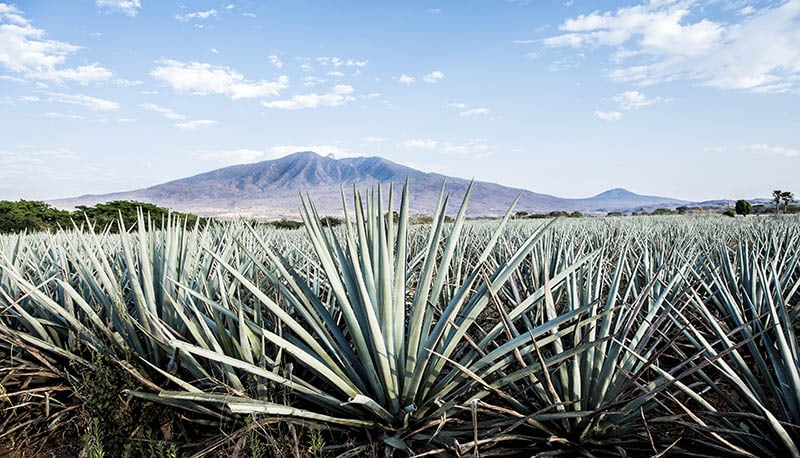16 Different Types of Agave Plants (With Pictures)
-
- Last updated:

Agave is best known for its use in the production of the alcoholic drink, tequila, but the sweet nectar of the plant is also used as a sweetener. The 250 different varieties of agave are used for a great many different purposes, including as ornamental and decorative plants for gardens and planters.
Below are 16 different types of agave plants to help you identify them or to help you choose the one that is best suited for your purpose.

The 16 Different Types of Agave Plants
1. American Century Agave
- Latin name: Agave Americana
The American century agave is a popular ornamental plant that has a dark blue-green center to its foliage with a lighter green-yellow frame. The leaves grow long and narrow and have a sharp point and the plant is known to attract hummingbirds.
2. Artichoke Agave
- Latin name: Agave parryi
The artichoke agave has broad blue-green leaves that have a black tip at the end. The plant loves full sun and is most often seen on rocky slopes but can do well in planters, as long as you have the sun and the heat.
3. Blue Agave
- Latin name: Agave tequilana
If agave is best known for its use in the production of tequila, then it’s the blue agave that most people think of. The plant has blue leaves and can grow tall, sometimes to 7 feet tall. It prefers sandy soil and can live for a very long time.
4. Butterfly Agave
- Latin name: Agave potatorum
The butterfly agave’s leaves are said to resemble the shape of a butterfly’s wings, hence its name. This is a slow-growing variant that grows to a medium size and is an especially good choice for planters.
5. Caribbean Agave
- Latin name: Agave Angustifolia
The Caribbean agave is a good choice for gardeners, as long as they take care when handling the very sharp tips that sit at the end of the variegated leaves. The leaves are green in the center with a lighter cream frame. The plant grows to approximately 4 feet and has a similar spread. It sometimes produces plantlets on the flower stalk, and these can be used for replanting.
6. Ferocious Giant Agave
- Latin name: Agave salmiana ferox
The ferocious giant agave has a powerful name and the form to match. It can grow to heights of ten feet and above and it has ferocious spines that are hooked and can be quite painful. The leaves are thick and broad, and the plant can produce yellow flowers.
7. Foxtail Agave
- Latin name: Agave attenuate
The foxtail agave is almost the polar opposite of the ferocious giant agave. It does not have teeth or spines. It grows relatively small, and it has a graceful foxtail-shaped rosette in the center, which gives this plant its name.
8. Hedgehog Agave
- Latin name: Agave stricta
The hedgehog agave is native to Southern Mexico. It has very narrow leaves which are tipped with sharp spikes and the plant has the appearance of a spiky ball.
9. Mountain Agave
- Latin name: Agave montana
This plant is known as the mountain agave because it resides at altitudes of 9,000 feet and above. It is a small plant that looks wild. It’s shade tolerant and is often found growing under the canopy of larger plants.
10. Octopus Agave
- Latin name: Agave vilmoriniana
The octopus agave is certainly one of the most unusual and quirky-looking agave plants, and it is obvious where it gets its name. It will grow to approximately 5 feet tall, and its spines and spikes are less aggressive than most other species.
11. Queen Victoria Agave
- Latin name: Agave Victoriae-Reginae
The Queen Victoria agave, or royal agave, is small for an agave. It has black-tipped leaves that form a ball shape. The plant lives to around 20 years and during the last stages of its life, it grows a 15-foot flower stalk and produces purple flowers.
12. Shaw’s Agave
- Latin name: Agave shawii
Shaw’s agave, which is also known as the coastal agave, is native to Baja Mexico and grows to be about 2 feet tall. Unfortunately, the plant, which can have red or gold spines in the sunlight, is critically endangered in its native home.
13. Smooth Agave
- Latin name: Agave desmettiana
The smooth agave is a good choice for gardeners that want an agave but without the danger of spikes. It is called the smooth agave because it doesn’t have spikes at the end of the lush green leaves.
14. Thread-Leaf Agave
- Latin name: Agave filifera
Growing to about two feet tall, the thread-leaf agave has a unique look thanks to the filaments that grow from the dark green leaves, which are also where the thread-leaf agave gets its name.
15. Twin-Flowered Agave
- Latin name: Agave geminiflora
The twin-flowered agave is also sometimes called the pincushion agave because it has hundreds of narrow, pointed leaves that create a rosette. The plant is quite small by agave standards with dark green leaves.
16. Whale’s Tongue Agave
- Latin name: Agave ovatifolia
The whale’s tongue agave is one of a few species that are cold tolerant. It is easier to grow than a lot of other species and it has broad, light green leaves with sharp points on the tops.

Conclusion
The agave plant is known for being used to produce tequila, but its nectar is also used as a sugar substitute and thanks to the 250 species of agave, there is an agave to suit most gardens and preferences including some of them ore unique-looking plants like the octopus agave and the pincushion agave.
Featured Image Credit: Jesus Cervantes, Shutterstock
Contents

